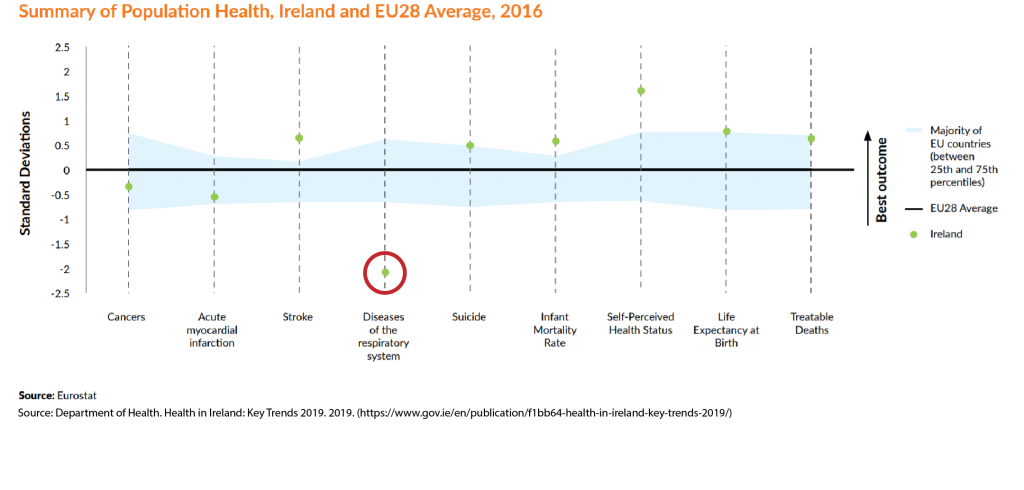
In this blog, Dr Helen McAvoy, Director of Policy at the Institute of Public Health, explores what we know about excess deaths from respiratory disease in socially disadvantaged communities, and asks what can be done to respond.
Recent developments on health inequalities
Earlier this month, the Northern Ireland Assembly Health Committee held a discussion on health inequalities. Members raised the issue of excess deaths from respiratory disease in deprived areas [1]. In this blog, I’ve explored the new data from Northern Ireland that prompted that debate [2]. Also this month, a new Healthy Ireland Strategic Action Plan [3] and Sláintecare [4] Implementation Strategy and Action Plan were published. These plans propose the development of new structures with enhanced potential to tackle inequalities in respiratory health.
Dying young from respiratory disease – data
Respiratory disease is a common cause of death in the population. When this large number of deaths combines with a wide inequality gap the result is devastating – far too many excess deaths in disadvantaged communities. Premature mortality is another feature – the lives of far too many people from poorer backgrounds are cut short by lung disease, robbed of the opportunity to enjoy retirement and old age. In Northern Ireland premature respiratory mortality ranks seventh in the top ten list of the largest inequality gaps included in their monitoring system.

The rate of respiratory death among under 75s in the most deprived areas of Northern Ireland is three and half times that of the least deprived. While the rate in the least deprived areas has remained the same, the rate in the most deprived areas is increasing. A recent analysis of English data frames this same phenomenon in a different way. Around one third of all premature deaths are attributable to socio-economic inequality, with respiratory cancers and chronic obstructive pulmonary disease (COPD) combined acting as the largest single contributor[5].
Unfortunately, we do not have a similar inequalities monitoring system in Ireland. A good starting point for considering inequalities in premature respiratory mortality in Ireland is to look at how Ireland fares overall on overall respiratory mortality. And the picture is disappointing. Age standardised death rates per 100,000 population from respiratory system diseases in Ireland were estimated to be around 40% higher than the EU-28 average [6].

The Irish Thoracic Society provides additional insights on the nation’s respiratory health. Between 2008 and 2016, the number of deaths from respiratory disease increased by 14.6%, while there was a 7.5% decline in cardiovascular deaths [7]. The Society highlighted that, while there are some data available on inequalities in lung cancer occurrence [8], there is very limited data on inequalities in respiratory mortality; and what is available is inevitably out of date.
Policy responses
Unlike cardiovascular disease [9] and cancer [10], there is no dedicated lung health/respiratory strategy in Ireland. Despite the existence of indicators to monitor inequalities, neither Ireland nor Northern Ireland has articulated a policy target to reduce inequalities in respiratory deaths.
In Northern Ireland, the Service Framework for Respiratory Health and Wellbeing (2015-18) is the de facto strategy at this time [11]. This sets out standards for service, across many domains including communications and involvement, health improvement/protection, social and emotional support, and in relation to specific respiratory conditions and services. The Framework includes a focus on enhancing detection, treatment and management of respiratory disease –crucial components of enhancing the lives of people living with the disease, with broadly similar developments being progressed in Ireland through the HSE Clinical Programmes on COPD and asthma [12] [13].
However, where tackling inequalities is the goal, an enhanced focus on primary prevention is likely to be required, in parallel with service developments (even when those service developments focus on equity). An equity-effective approach will require an ‘upstream’ focus on reducing the occurrence of respiratory disease, or delaying its onset, at population level and with targeted attention to disadvantaged communities. This requires both a strategic, and operational, focus on addressing the excess exposure of certain communities to risk factors for respiratory disease – tobacco smoke, poor quality air and housing and a lower standard of nutrition and general health.
A positive development in Northern Ireland is an increased equity focus in tobacco control policy and in the operation of stop smoking services [14]. In Ireland, another positive development is the new Healthy Ireland Strategic Action Plan [15] which includes commitments to resource health improvement in disadvantaged communities, including additional stop smoking services. Recent initiatives from the Health Service Executive Tobacco Free Ireland programme are increasingly focussed on enhancing smoking cessation in disadvantaged communities. These initiatives include:
- The community-based ’We Can Quit’ programme We Can Quit – Findings from the Action Research Study FULL REPORT
- An equity focus within the forthcoming Clinical Guidelines on Treatment of Tobacco Dependence
- A programme of enhanced engagement with mental health service users and providers [16].
A recently formed UK and Ireland network intends to share best practice on reducing second-hand smoke exposure with a focus on disadvantaged households [17].
The British Lung Foundation has called for the establishment of an independent respiratory health taskforce for England to address inequalities in lung health. The taskforce would develop a strategy for a national, joined up approach for reducing inequalities in respiratory outcomes [18].
A comprehensive approach is needed – with equity focused tobacco control and stop smoking services as a cornerstone. However, enhancing the quality of air and the quality of housing for people living on low incomes is also paramount, as is reducing harmful occupational lung exposures for manual workers. Developments in environmental, housing and employment policies may be important avenues to benefit the lung health of disadvantaged communities, provided they include a health equity lens. Building on the learning from COVID-19, resourcing the health protection workforce to achieve equity across vaccination, control of antimicrobial resistance and tuberculosis can drive progress in reducing respiratory deaths in disadvantaged communities [19].
The last word
Over 20 years ago, the Institute of Public Health published a report on inequalities in mortality on the island of Ireland. This found that mortality from respiratory diseases had the widest occupational class difference [20]. IPH is working with the Economic and Social Research Institute to provide updated estimates of inequalities in mortality in Ireland, bringing us closer to having an all-island picture [21]. However, if the picture from Northern Ireland for respiratory deaths is anything to go by, enhanced policy responses may be needed. Dying young from lung disease is an all too common occurrence in disadvantaged communities – a problem we cannot ignore if we are truly committed to leaving no one behind.
References
1. NI Assembly TV. Committee for Health Meeting Thursday 6 May 2021. Available from: https://niassembly.tv/committee-for-health-meeting-thursday-6-may-2021/ [Accessed: 18 May 2021]
2. Carson P, Blakley H, Caolan L. Health Inequalities: Annual Report 2021. 2021. Available from: https://www.health-ni.gov.uk/sites/default/files/publications/health/hscims-report-2021_1.pdf [Accessed: 18 May 2021]
3. Department of Health. Healthy Ireland Strategic Action Plan 2021-2025. 2021. Available at: gov.ie – Healthy Ireland Strategic Action Plan 2021-2025 (www.gov.ie) [Accessed 19 May 2021]
4. Department of Health. Sláintecare Implementation Strategy and Action Plan 2021-23. 2021.Available at: gov.ie – Government approves Sláintecare Implementation Strategy and Action Plan 2021-23 (www.gov.ie) [Accessed 19 May 2021]
5. Lewer D, Jayatunga W, Aldridge RW, Edge C, Marmot M, Story A, Hayward A. Premature mortality attributable to socioeconomic inequality in England between 2003 and 2018: an observational study. The Lancet Public Health. 2020 Jan 1;5(1):e33-41.
6. Department of Health. Health in Ireland: Key Trends 2019. 2019. Available from: https://www.gov.ie/en/publication/f1bb64-health-in-ireland-key-trends-2019/ [Accessed 18 May 2021]
7. Irish Thoracic Society. Respiratory Health of the Nation. 2018. Available from: https://irishthoracicsociety.com/wp-content/uploads/2018/12/RESP-Health-LATEST19.12.pdf [Accessed 18 May 2021]
8. Walsh PM, McDevitt J, Deady S, O’Brien K, Comber H. Cancer inequalities in Ireland by deprivation, urban/rural status and age: a National Cancer Registry report. Cork: National Cancer Registry Ireland. 2016.
9. Department of Health. Changing Cardiovascular Health: National Cardiovascular Health Policy 2010 – 2019. 2010. Available from: https://www.gov.ie/en/publication/481948-changing-cardiovascular-health-national-cardiovascular-health-policy/ [Accessed 18 May 2021]
10. Department of Health. National Cancer Strategy 2017 – 2026. 2017. https://www.gov.ie/en/publication/a89819-national-cancer-strategy-2017-2026/?referrer=/blog/publications/national-cancer-strategy-2017-2026/ [Accessed 18 May 2021]
11. Department of Health, Social Services and Public Safety. Service Framework for Respiratory Health and Wellbeing 2015 -18. https://www.health-ni.gov.uk/sites/default/files/publications/dhssps/service-framework-respiratory-2015-18_0.pdf [Accessed 18 May 2021]
12. Health Service Executive. Chronic Obstructive Pulmonary Disease. 2021. Available from: https://www.hse.ie/eng/about/who/cspd/ncps/copd/ [Accessed 18 May 2021]
13. Health Service Executive. Asthma. 2021. Available from: https://www.hse.ie/eng/about/who/cspd/ncps/asthma/ [Accessed 18 May 2021]
14. Purdy, J., McAvoy, H. and Rodriguez, L. Mid-Term Review of the Ten Year Tobacco Strategy for Northern Ireland – Evidence Review developed by the Institute of Public Health for the Department of Health in Northern Ireland. 2020.
15. Healthy Ireland. Healthy Ireland Strategic Action Plan 2021-2025. Department of Health; 2021.
16. HSE Tobacco Free Ireland Programme. HSE Tobacco Free Ireland Programme Implementation Plan 2018-2021. Available from: https://www.hse.ie/eng/about/who/tobaccocontrol/hse-tfi-2018-2021-plan/hse-tfi-plan-2018-2021-final.pdf [Accessed 18 May 2021]
17. Irish Research Council. New network to explore ways to help reduce smoking in the home. 02 March 2021. Available from: https://research.ie/what-we-do/loveirishresearch/blog/new-network-to-explore-ways-to-help-reduce-smoking-in-the-home/ [Accessed 18 May 2021]
18. British Lung Foundation. Briefing: health inequalities and lung disease. https://www.blf.org.uk/sites/default/files/British%20Lung%20Foundation%20-%20Lung%20disease%20and%20health%20inequalities%20briefing.pdf [Accessed 18 May 2021]
19. Doherty, L. Health Protection Inequalities on the Island of Ireland An Introductory Paper. Institute of Public Health; 2016.
20. Balanda, K and Wilde, J. Inequalities in Mortality: A report on all Island Mortality Data 198-1998. The Institute of Public Health in Ireland, 2001.
21. Economic & Social Research Institute. Unequal Chances – Inequalities in Mortality in the Republic of Ireland. 2021. Available from: https://www.esri.ie/current-research/unequal-chances-inequalities-in-mortality-in-the-republic-of-ireland [Accessed 18 May 2021]


